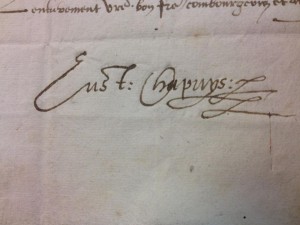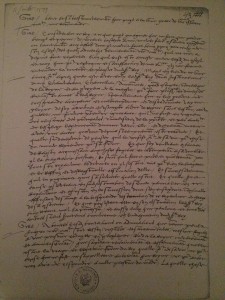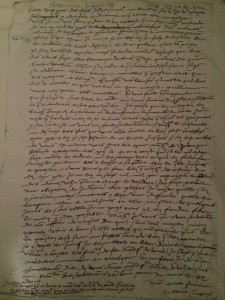
Thank you so much to Lauren Mackay for sharing her thoughts on Eustace Chapuys, the Imperial ambassador, with us today as part of her book tour. I’ve been corresponding with Lauren for a number of years and I’m thrilled that she’s written a biography on Chapuys, a fascinating man and an invaluable primary source. Over to Lauren…
What made you want to write about Chapuys?
Eustace Chapuys has been on my mind for over a decade. He intrigued me from the very beginning: one of our most important sources, a vital narration of the Tudor period, and yet he was nothing more than a name at the bottom of a page. During my Master’s thesis on the Boleyn men, I found that Chapuys loomed large in my writing, and I felt it was time to tell the story of the Tudor court through his eyes.
Where did your research take you?
I travelled to Annecy, where he was born. Now part of France, Annecy was once a bustling market town, part of the independent state of Savoy. His portraits are hidden away in various galleries and schools in Annecy. I spent some time alone with them – I was transfixed. I also held his personal letters and despatches in Annecy and Vienna, travelled to Brussels to see the 18th century translations of some of the lost letters, as well as London, Lyon and Paris.

What were some of the most exciting letters you held?
The letters of January, April and May, 1536, as well as his last despatch from England. I remember rifling through 1535/1536, and coming to his letter following Katherine of Aragon’s death. His writing is erratic, he is agitated, distraught. There is an angularity to his form. Something shifted in him with Katherine’s death, and it is there on the page. Holding his letter of 17 May was a highlight. It’s partially in cipher, and Chapuys has scrawled in the margins, but it’s an incredible letter, allowing us a glimpse of his own thoughts of the coup against Anne, the condemned men, and Anne’s fears.


Why is Chapuys used so selectively as a source? A number of writers have described him as untrustworthy. Does this frustrate you as his biographer?
Any misuse of a source is frustrating, but it is the conscious effort to twist his words and belittle his principles which is most damaging. Attitudes towards Anne Boleyn have affected our perceptions, a simplistic analysis has been adopted: Anne is a victim, therefore Chapuys is the misogynistic, deceptive and insidious villain. Chapuys is one of Anne’s most important biographers, through his despatches she emerges as so much more than a mere victim, or ambitious harpy. His words allow for that nuance which is so often missing from her biographies. My research has demonstrated that Chapuys did not only refer to Anne as the Concubine. Even when he referred to her as the Lady, it is said that he “disgustedly” referred to her as such. But Chapuys referred to other women the same way, it does him a disservice to force such a hostile tone into his words. From 1529 to 1533, Anne was referred to as Anne Boleyn, The Lady, Mademoiselle Anne, Lady Anne etc. From 1533 to 1536, he refers to her as the Concubine once. The title crops up when he is under emotional stress. From 1536, after Katherine’s death and Henry’s reaction to it, something in him shifts, and he does become more hostile. It is also worth noting that Chapuys is careful to preface any rumours with his own opinion as to their credibility. Chapuys’ job was to provide Charles with accurate information, and he felt obliged to include every piece of information. If Chapuys did distort the truth or conjure up a story, Charles would have quickly found out from his other ambassadors and sources, and Chapuys’ reputation would be worth nothing. His observations could be harsh, but that does not make them untrue. He was often ahead of the game when it came to news, and there are numerous incidents in which he has discovered information before other embassies.
Did Chapuys believe the charges against Anne?
Not at all, and he was clear about that. Nor did he believe George had committed incest or was guilty of any crime. He admired George’s behaviour during his trial, and seemed shocked that he was convicted. Chapuys even notes that Henry’s decision to have George and the condemned men executed so close to Anne’s lodgings was a final, cruel gesture. Chapuys admired Anne and George in those last days, and their deaths continued to haunt him for weeks to come.
Did Anne Boleyn really “trick” Chapuys into acknowledging her?
So many historians have become fixated on this incident. There is no indication that Anne had engineered it at all. The original letter is very clear: Chapuys is aware that everyone is waiting to see how Anne and Chapuys will act when in the same room. He bows to the royal couple, which he has obviously done before, but this time Anne turns to acknowledge the bow. Chapuys seems surprised, and almost pleased by her behaviour, as though he’s worried she was about to insult him. He tells Charles that he finds her affable and courteous, and clearly states that he was making reverence to her. “She turned around to return the reverence I had made to her” There was no trick. Chapuys thinks no more of it, and goes off to dine with George Boleyn and the other councillors. Anne later asks why Henry did not allow Chapuys to dine with them. Considering France had cooled towards them, it is interesting that Anne seems to be considering the Imperial option.
Your PhD is on the Boleyn men, what is it like writing from perspectives of men who were on opposite sides of the board?
They barge in on each-other constantly in my writing, though Chapuys had a good relationship with George and Thomas. He found them both to be intelligent men, and admired Thomas’ skill in diplomacy. He found George a little aggressive when it came to religion, but he certainly never avoided them, and engaged in numerous conversations with them both. I think his reaction to George’s execution denotes his respect for them.
What else are you working on?
Apart from my PhD, I am also working on several journal articles, and my next book, which will be about Thomas Howard, the Duke of Norfolk.
Giveaway
Lauren’s book, Inside the Tudor Court, was released in February 2014 and you can read my review of it on our Tudor Book Review site – click here. Amberley Publishing have kindly donated one copy of Inside the Tudor Court for a giveaway. All you have to do is comment below sharing why you want to know more about Chapuys by midnight on Friday 4th April (GMT) and one lucky winner will be picked at random. There will be further chances to win a book at the other stops on Lauren’s book tour:
- 1st April, Anne Boleyn: From Queen to History, author summary of the book
- 2nd April, Nerdalicious, author article about her research/travelling for the book
- 3rd April, On the Tudor Trail- Retracing the steps of Anne Boleyn, extract from Inside the Tudor Court
- 4th April, Tudor Book Blog, author interview
- 5th April, Tudorhistory.org, extract from Inside the Tudor Court
- 6th April, Le Temps Viendra: A Novel of Anne Boleyn, extract from Inside the Tudor Court, plus a brief guide to following in Chapuys’ footsteps in his home town of Annecy.